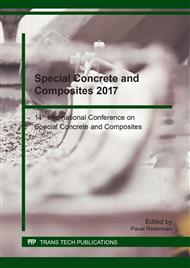[1]
V. Rahhal, V. Bonavetti, A. Delgado, C. Pedrajas, R. Talero, Scheme of the Portland cement hydration with crystalline mineral admixtures and other aspects, Silicates Industriels. 74/11-12 (2009) 347–352.
Google Scholar
[2]
P. Reiterman, J. Pazderka, Crystalline Coating and Its Influence on the Water Transport in Concrete, Advances in Civil Engineerings 2016 (2016) Article ID 2513514.
DOI: 10.1155/2016/2513514
Google Scholar
[3]
J. Pazderka, E. Hájková, The Speed of the Crystalline Admixture's Waterproofing Effect in Concrete, Key Engineering Materials. 722 (2017) 108-112.
DOI: 10.4028/www.scientific.net/kem.722.108
Google Scholar
[4]
N. Bowling, Concrete admixture stabilizes tallest building in European Union, Building Design & Construction. (2012).
Google Scholar
[5]
L. Connell, Crack repair system stops water in its tracks, "Concrete International. 29/5 (2007) 50–52.
Google Scholar
[6]
V. T. N. Dao, P. F. Dux, P. H. Morris, A. H. Carse, Performance of permeability-reducing admixtures in marine concrete structures, ACI Materials Journal. 107/ 3 (2010) 291–296.
DOI: 10.14359/51663758
Google Scholar
[7]
F. Klouda, Concrete crystallisation gives India's greenest airport wings, Concrete. 44/3 (2010) 33–34.
Google Scholar
[8]
H.J. Ji, Y. Yang, S. -G. Zhou, Y. Yuan, Tentative study of a new cement waterproof paint, Journal of Xi'an University of Architecture and Technology. 40/1 (2008) 80–86.
Google Scholar
[9]
R. L. Munn, G. Kao, Z. T. Chang, Performance and compatibility of permeability reducing and other chemical admixtures in Australian concretes, Proc. of the 7th CANMET/ACI International Conference on Superplasticizers and Other Chemical Admixtures in Concrete. (2003).
DOI: 10.14359/12925
Google Scholar
[10]
X. Shaozhu, Research and development of cement-based permable crystallization type waterproof materials abroad, China Building Waterproofing. 6 (2001).
Google Scholar
[11]
K. Wang, T. Hu, S. Xu, Influence of permeated crystalline waterproof materials on impermeability of concrete, Advanced Materials Research 446–449 (2012) 954–960.
DOI: 10.4028/www.scientific.net/amr.446-449.954
Google Scholar
[12]
G.M. Wang, J.Y. Yu, Effect of catalytic crystalline waterproofing coating on performance and microstructure of concrete, Journal of Wuhan University of Technology. 28/3 (2006) 29–31.
Google Scholar
[13]
Y. Zhang, X. Du, Y. Li, F. Yang, Z. Li, Research on cementitious capillary crystalline waterproofing coating for underground concrete works, Advanced Materials Research 450-451 (2012) 286–290.
DOI: 10.4028/www.scientific.net/amr.450-451.286
Google Scholar
[14]
J. Pazderka, E. Hájková, Crystalline Admixtures and their Effect on Selected Properties of Concrete, Acta Polytechnica 56/4 (2016) 306-311.
DOI: 10.14311/ap.2016.56.0306
Google Scholar
[15]
J. Pazderka, Concrete with Crystalline Admixture for Ventilated Tunnel against Moisture, Key Engineering Materials 677 (2016) 108-113.
DOI: 10.4028/www.scientific.net/kem.677.108
Google Scholar
[16]
EN 12390-8 Testing hardened concrete - Part 8: Depth of penetration of water under pressure, European Committee for Standardization, Brussels, (2009).
Google Scholar
[17]
EN 206-1 Concrete - Part 1: Specification, performance, production and conformity, European Committee for Standardization, Brussels, (2000).
Google Scholar
[18]
R. Barnes, Permeability Testing of Site Concrete, The Concrete Society, Camberley, UK, (2008).
Google Scholar


